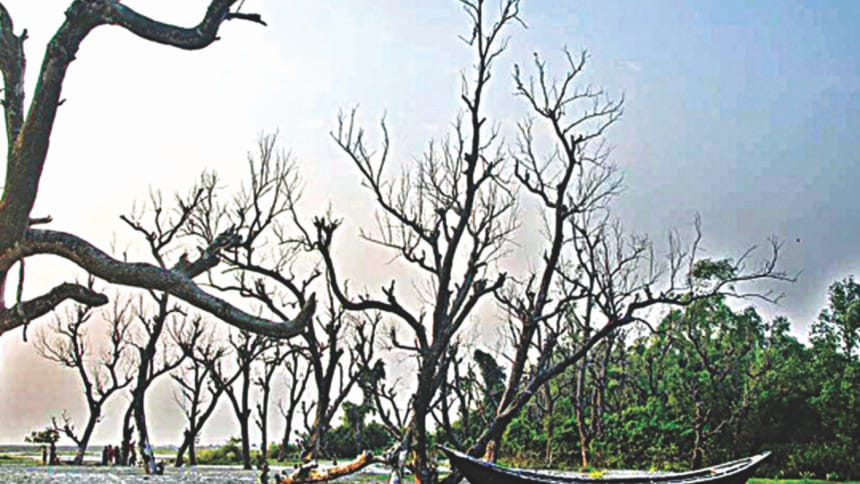Transforming migration

Perhaps the most controversial issue in the global climate change literature is migration. During the 1990s and early 2000s, in climate change discourse, migration was presented as a threat. These studies perceived climate change as an independent variable driving migration from ecologically vulnerable areas. Those who moved were termed as a new group of forced migrants or environmental refugees. Subsequent studies underscored that migration is a complex and multi-causal phenomenon. Along with the influence of climate change, migratory behaviour is also shaped by other macro issues such as social, political, economic and demographic influences. Micro-level realities like household characteristics and meso-level facilitating or intervening factors play a role in inducing or restricting migration of individuals, households, or communities.
Two strands of debate currently dominate the migration and climate change discourse. The first one is environmental determinism versus multi-causality. The other strand is migration as one of the adaptation tools versus migration as failure of local level adaptation. This article identifies different migration experiences of people from climate hotspots of Bangladesh and shows that people are autonomously using livelihood migration as one of the adaptation tools; but lack of understanding and coordination among government agencies and action plans work as hindrances in the process of an integrative approach that accommodate local level adaptation programmes with livelihood migration and resettlement of the displacees.
Considering the climatic characteristics of Bangladesh and the trend of exacerbation of climate related hazards in coming years, studies inform that the volume of certain types of population movements are likely to increase in Bangladesh. It is important to note that all types of population movements are not equally sensitive to climate change. The result of sensitivity tests conducted by RMMRU-Sussex Centre for Migration Research (2014) shows that both internal displacement and internal livelihood rural to urban migration are highly sensitive to climate change, whereas cross border population movement and short term international contract migration had mixed sensitivity to climate change and long term permanent migration to the west had extreme low sensitivity.
On climate hazard related displacement some estimates have already begun to surface. Global estimate of Brown (2008) suggests that by 2050 one in every 45 people of the world will be displaced by climate change, and in case of Bangladesh one in every seven people will be displaced. The Internal Displacement Monitoring Centre (IDMC) estimates that more than 4.7 million people were displaced due to disasters in Bangladesh from 2008 to 2014. A UNDP (2013) study, identified that population growth in environmentally fragile areas, especially in the coastal regions, experienced low population growth over the last two decades compared to the national average. Again, a RMMRU-SCMR study (2014), based on historical analysis of upazila level census data of 2001, and 2001 predictions of global climate models and World Bank studies of 2010 and 2011, estimates that as many as 16 to 26 million Bangladeshis will migrate from places of origin due to floods, storm surges, riverbank erosion and sea level rise in the period 2011 to 2050. Of this 2 to 5 million will migrate due to riverbank erosion, 3 to 6 million due to inland flooding, 5 to 7 million due to coastal storm surges and 6 to 8 million due to sea level rise.
While respecting the rights of affected people to stay put in places of origin, policies should also respect the desire of those who would choose to migrate. Such conceptualisation raises new challenges.
Comprehensive Disaster Management Programme (CDMP II) of the Government of Bangladesh conducted a nationally representative baseline survey in 2014 to assess the magnitude and patterns of climate induced displacement in Bangladesh. It looked into four types of environmental hazards. These are floods, riverbank erosion, salinity and water logging. It found that 12 percent of the population was permanently displaced due to climate change, 46 percent of the population experienced temporary displacement, while another 29 percent swung between temporary and permanent displacement. Only 13 percent of the households in those districts had never experienced any form of displacement. In other words, more than 85 percent of the survey population in environmentally fragile areas had experienced some form of displacement.
Abrar and Azad (2004) showed that those who are displaced initially try to resettle themselves in nearby areas and if they fail, only then they migrate to nearby districts or gradually to mega-cities like Dhaka and Chittagong.

Siddiqui (et al, 2016) found that majority of people of Patuakhali, Lakshmipur and Sirajganj who were displaced by river bank erosion and coastal erosion have resettled themselves by the side of the embankments, and a section of them have moved to different urban locations. Health, hygiene, sanitation conditions in both embankments as well as in urban slums is extremely poor. Young and adolescent girls and children are particularly vulnerable to different forms of harassment. In all these areas government has developed some resettlement sites such as Ashrayon and Guccho Gram. In the resettlement sites the living arrangement is much better compared to that of in the embankment, as well as security concerns are also less for the family members. A major problem of these resettlement sites is the residents' access to work. This has led to situations in which those resettled had sold their allocated land and moved to locations close to their work.
In September 2015 the Ministry of Disaster Management framed a national strategy on the management of disaster and climate induced displacement. The draft is a rights based document and it tries to ensure protection of the displacees at all the stages. It consists of four strategic responses. These are prevention, preparation, management and address. Prevention is aimed at reducing displacement by undertaking all kinds of infrastructure development interventions. There will be situations where people will have to relocate themselves. Preparation informs people of likelihood of relocation and steps required for doing so. Management entails the activities that governments and civil society need to undertake to help those on the move during displacement. The last component refers to durable solutions such as return, local integration and resettlement of those who have already moved. The document was prepared under CDMP II of the Ministry of Disaster Management. However, the government is yet to implement it.
All the figures mentioned above highlight the displacement aspect of population movement due to environmental and climate change related hazards. But displacement is only one form of population movement. There are many other forms of migration which will also be influenced by climate change. Rural to urban temporary labour migration is the most dominant among them. Currently an origin area survey is underway under the Deltas, Vulnerability and Climate Change: Migration and Adaptation (DECCMA) project, which is a five country research consortium. This research highlights the voluntary labour migration scenario from fifty climate hotspots of Bangladesh. It listed 8,713 households in these hotspots. Interestingly, 35 percent of these households are labour migrant households. This means that at least one member of these households had migrated for livelihood either internally or internationally. Of these 35 percent migrant households, almost two-thirds were internal migrants and one-third was international migrant households. A large segment of the household expenditures of these migrant households are gathered from the remittances sent by their migrant family members.
Siddiqui et al (2016) found that those families have adapted better to different stresses of climate change which combined local level livelihoods with livelihood migration of a few members of the households. Migration of household members provided better income and financial situation to migrants compared to non-migrant households. They found that economic status of 6.1 percent of migrant households before migration was sufficient. But after migration of a few family members, it has increased to 10 percent. Five percent of non-migrant households belonged to the "always sufficient" category. They attempted to adapt locally. Their percentage share in the "always sufficient" category has dropped to 2.5 percent. The number of persons in the category of "just sufficient" has also increased in case of migrant households. But it has decreased in case of non-migrant households. The number of households in "occasional" and "chronic deficit" has reduced in case of migrant households whereas it increased in case of non-migrant households. The study also found that a section of households that are trying to adapt only locally might have trapped themselves into "occasional" or "chronic poverty". This means that people of climate change affected areas autonomously used livelihood migration as one of the adaptation tools.
Without going into the debate how much of it is climate induced and how much is due to other economic, social or political factors, we can still argue that these types of voluntary livelihood migration flows from the climate affected areas will also have to be managed and governed, so that their rights to benefit from the climate change adaptation measures are enjoyed by them. The problem here is that government, civil society bodies and development partners look at migration as failure to local level adaptation. Therefore, through National Adaptation Programme of Action (NAPA), Bangladesh Climate Change Strategy and Action Plan (BCCSAP) or sectoral policies like disaster management, they attempt to reduce migration by creating local level adaptation opportunities. They also look at rural-urban migration as a problem of urban management as they confront the reality of migrants creating tremendous pressure on urban amenities of Dhaka and Chittagong. Some of the government documents identify migrants as source of major problems in the urban areas. Without evidence, the common statements made in policy documents equate migrants with crime, drug trafficking etc. However, many of these problems are not related to migration. Rather they are related to the type of urban growth policy that the government pursues.
For ages, the government has been developing two mega-cities: Dhaka and Chittagong. There is no effort to decentralise growth centres and create spaces for service providers close to the growth centres. Climate change funds can be invested in developing growth centres close to climate change affected areas. The same fund should also be spent in increasing low cost connectivity with decentralised growth centres and urban peripheries where the migrants can enjoy decent living conditions instead of crowding the cities.
In conclusion I would argue that the time has come to integrate all policies and strategies such as the climate change policy, internal migration policy, urbanisation and decentralisation policies, and develop a comprehensive framework that respects the inter-linkages of all the above challenges. The strategy of managing internal displacement is a great initiative of the government. It needs to be implemented with urgency. A similar strategy is required to manage livelihood migration in the context of climate change. Adaptation programmes in Bangladesh should not set goals to prevent labour migration as it hinders people's choice of mobility. While respecting the rights of affected people to stay put in places of origin, policies should also respect the desire of those who would choose to migrate. Such conceptualisation raises new challenges. To ensure access of climate affected people to short term international migration, new types of interventions have to be designed at the local level. This entails implementation of the 2011 National Skills Development Policy, establishment of international migration processing government agencies, including migration loan providing banks, close to climate change affected areas.
The writer is Professor of political science, University of Dhaka and Founding Chair, RMMRU

 For all latest news, follow The Daily Star's Google News channel.
For all latest news, follow The Daily Star's Google News channel. 



Comments